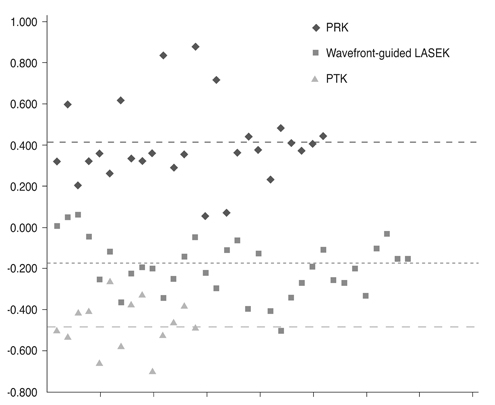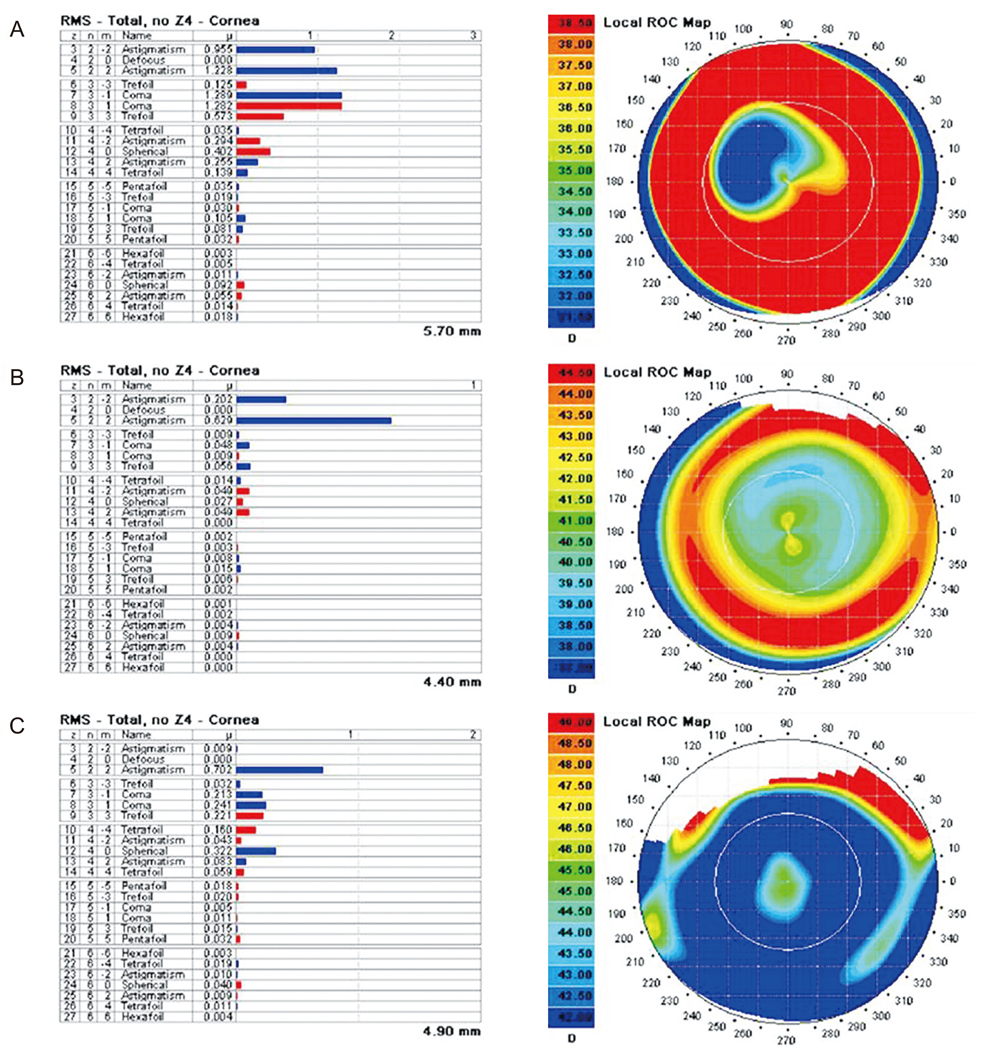Korean J Ophthalmol.
2013 Apr;27(2):81-86. 10.3341/kjo.2013.27.2.81.
Changes in Spherical Aberration after Various Corneal Surface Ablation Techniques
- Affiliations
-
- 1S-Eye Center, Ansan, Korea.
- 2Kim's Eye Hospital, Seoul, Korea.
- 3Department of Ophthalmology, Institute of Vision Research, Yonsei University College of Medicine, Seoul, Korea. tikim@yuhs.ac
- 4Severance Biomedical Science Institute, Brain Korea 21 Project for Medical Science, Yonsei University College of Medicine, Seoul, Korea.
- KMID: 1503797
- DOI: http://doi.org/10.3341/kjo.2013.27.2.81
Abstract
- PURPOSE
The corneal change induced by refractive procedures influence both the postoperative refractive status and the ocular spherical aberration (SA). We evaluated changes in corneal SA after three types of surface ablation: phototherapeutic keratectomy (PTK), myopic photorefractive keratectomy (PRK), and myopic wavefront-guided laser epithelial keratomileusis (LASEK).
METHODS
Twenty-six eyes (25 patients) were subjected to PTK 26 eyes (14 patients) to PRK, and 34 eyes (17 patients) to wavefront-guided LASEK. Corneal SA was measured with the iTrace in all patients both preoperatively and 6 months postoperatively.
RESULTS
Six months after surgery, mean corneal SA was -0.173 +/- 0.171 micrometer in the PTK group, 0.672 +/- 0.200 micrometer in the PRK group, and 0.143 +/- 0.136 micrometer in the wavefront-guided LASEK group. The mean difference between the preoperative and postoperative corneal SA (DeltaSA) was -0.475 micrometer in the PTK group, 0.402 micrometer in the PRK group, and -0.143 micrometer in the wavefront-guided LASEK group.
CONCLUSIONS
Surgically induced changes in corneal SA vary with procedure. The prediction of the pattern of SA change induced by various surface ablation procedures may be helpful for developing future surgical procedures.
Keyword
MeSH Terms
Figure
Reference
-
1. Waring GO 4th, Durrie DS. Emerging trends for procedure selection in contemporary refractive surgery: consecutive review of 200 cases from a single center. J Refract Surg. 2008. 24:S419–S423.2. Alio JL, Schimchak P, Negri HP, Montes-Mico R. Crystalline lens optical dysfunction through aging. Ophthalmology. 2005. 112:2022–2029.3. Artal P, Guirao A, Berrio E, Williams DR. Compensation of corneal aberrations by the internal optics in the human eye. J Vis. 2001. 1:1–8.4. Buzzonetti L, Iarossi G, Valente P, et al. Comparison of wavefront aberration changes in the anterior corneal surface after laser-assisted subepithelial keratectomy and laser in situ keratomileusis: preliminary study. J Cataract Refract Surg. 2004. 30:1929–1933.5. Hersh PS, Fry K, Blaker JW. Spherical aberration after laser in situ keratomileusis and photorefractive keratectomy: clinical results and theoretical models of etiology. J Cataract Refract Surg. 2003. 29:2096–2104.6. Lombardo M, Lombardo G, Manzulli M, et al. Relative contribution of central and peripheral aberrations to overall high order corneal wavefront aberration. J Refract Surg. 2006. 22:656–664.7. Sakata N, Tokunaga T, Miyata K, Oshika T. Changes in contrast sensitivity function and ocular higher order aberration by conventional myopic photorefractive keratectomy. Jpn J Ophthalmol. 2007. 51:347–352.8. Nanba A, Amano S, Oshika T, et al. Corneal higher order wavefront aberrations after hyperopic laser in situ keratomileusis. J Refract Surg. 2005. 21:46–51.9. Holladay JT, Piers PA, Koranyi G, et al. A new intraocular lens design to reduce spherical aberration of pseudophakic eyes. J Refract Surg. 2002. 18:683–691.10. Winkler von Mohrenfels C, Huber A, Gabler B, et al. Wavefront-guided laser epithelial keratomileusis with the wavelight concept system 500. J Refract Surg. 2004. 20:S565–S569.11. Chung SH, Lee IS, Lee YG, et al. Comparison of higher-order aberrations after wavefront-guided laser in situ keratomileusis and laser-assisted subepithelial keratectomy. J Cataract Refract Surg. 2006. 32:779–784.12. Wigledowska-Promienska D, Zawojska I. Changes in higher order aberrations after wavefront-guided PRK for correction of low to moderate myopia and myopic astigmatism: two-year follow-up. Eur J Ophthalmol. 2007. 17:507–514.13. Llorente L, Barbero S, Merayo J, Marcos S. Total and corneal optical aberrations induced by laser in situ keratomileusis for hyperopia. J Refract Surg. 2004. 20:203–216.14. Gatinel D, Malet J, Hoang-Xuan T, Azar DT. Corneal asphericity change after excimer laser hyperopic surgery: theoretical effects on corneal profiles and corresponding Zernike expansions. Invest Ophthalmol Vis Sci. 2004. 45:1349–1359.15. Albarran-Diego C, Munoz G, Montes-Mico R, et al. Corneal aberration changes after hyperopic LASIK: a comparison between the VISX Star S2 and the Asclepion-Meditec MEL 70 G Scan excimer lasers. J Refract Surg. 2006. 22:34–42.16. Pesudovs K. Wavefront aberration outcomes of LASIK for high myopia and high hyperopia. J Refract Surg. 2005. 21:S508–S512.17. Ginis HS, Katsanevaki VJ, Pallikaris IG. Influence of ablation parameters on refractive changes after phototherapeutic keratectomy. J Refract Surg. 2003. 19:443–448.18. Denoyer A, Le Lez ML, Majzoub S, Pisella PJ. Quality of vision after cataract surgery after Tecnis Z9000 intraocular lens implantation: effect of contrast sensitivity and wavefront aberration improvements on the quality of daily vision. J Cataract Refract Surg. 2007. 33:210–216.19. Johansson B, Sundelin S, Wikberg-Matsson A, et al. Visual and optical performance of the Akreos Adapt Advanced Optics and Tecnis Z9000 intraocular lenses: Swedish multicenter study. J Cataract Refract Surg. 2007. 33:1565–1572.20. Moorfields IOL Study Group. Allan B. Binocular implantation of the Tecnis Z9000 or AcrySof MA60AC intraocular lens in routine cataract surgery: prospective randomized controlled trial comparing VF-14 scores. J Cataract Refract Surg. 2007. 33:1559–1564.21. Marcos S, Barbero S, Jimenez-Alfaro I. Optical quality and depth-of-field of eyes implanted with spherical and aspheric intraocular lenses. J Refract Surg. 2005. 21:223–235.22. Piers PA, Manzanera S, Prieto PM, et al. Use of adaptive optics to determine the optimal ocular spherical aberration. J Cataract Refract Surg. 2007. 33:1721–1726.23. Packer M, Fine IH, Hoffman RS. Aspheric intraocular lens selection based on corneal wavefront. J Refract Surg. 2009. 25:12–20.24. Beiko GH. Personalized correction of spherical aberration in cataract surgery. J Cataract Refract Surg. 2007. 33:1455–1460.25. Rocha KM, Soriano ES, Chalita MR, et al. Wavefront analysis and contrast sensitivity of aspheric and spherical intraocular lenses: a randomized prospective study. Am J Ophthalmol. 2006. 142:750–756.26. Koch DD, Wang L. Custom optimization of intraocular lens asphericity. Trans Am Ophthalmol Soc. 2007. 105:36–41.
- Full Text Links
- Actions
-
Cited
- CITED
-
- Close
- Share
- Similar articles
-
- Comparison between Anterior Corneal Aberration and Ocular Aberration in Laser Refractive Surgery
- Long-Term Results of Presbyopic Corneal Surface Ablation with Eximer Laser
- Anterior and Posterior Corneal Spherical Aberration Measured With Pentacam in the Korean
- Clinical Outcomes of Cataract Surgery with Correction of Corneal Spherical Aberration
- Estimation of Corneal Spherical Aberration from Topography



